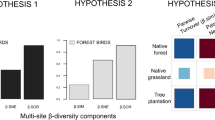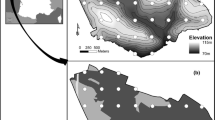Abstract—
According to published data on bird abundance in Europe, the chaffinch has proved to be the most abundant species. To reveal the causes of its absolute dominance in all bird communities оf the European forest zone, an analysis has been made of parameters characterizing the ecological niche, reproduction, migrations, survival rate, and other aspects of the life strategy of this species in comparison with two other highly abundant bird species. The results show that the strategies of the chaffinch and the willow warbler (Phylloscopus trochilus)—a species from a different family—are highly similar, while those of the chaffinch and the closely related brambling (Fringilla montifringilla) significantly differ from each other.


Similar content being viewed by others
REFERENCES
Ricklefs, R.E., The Economy of Nature: A Textbook in Basic Ecology, Portland: Chiron Press, 1976. Translated under the title Osnovy obshchei ekologii, Moscow, Mir, 1979.
Whittaker, R.H., Communities and Ecosystems, 2nd ed., New York: Macmillan, 1975. Translated under the title Soobshchestva i ekosistemy, Moscow: Progress, 1980.
Begon, M., Harper, J.L., and Townsend, C.R., Ecology: Individuals, Populations, and Communities, Oxford: Blackwell, 1986. Translated under the title Ekologiya: Osobi, populyatsii i soobshchestva, Moscow: Mir, 1989.
Magurran, A.E., Ecological Diversity and Its Measurement, Springer Netherlands, 1988. Translated under the title Ekologicheskoe raznoobrazie i ego izmerenie, Moscow: Mir, 1992.
Böhning-Gaese, K. and Bauer, H.-G., Changes in species abundance, distribution, and diversity in a central European bird community, Conserv. Biol., 1996, vol. 10, pp. 175−187.
The EBCC Atlas of European Breeding Birds: Their Distribution and Abundance, Hagemeijer, E.J.M. and Blair, M.J., Eds., London: T. & A.D. Poyser, 1997.
Otsenka chislennosti i ee dinamika dlya ptits Evropeiskoi chasti Rossii (“Ptitsy Evropy - II”) (Birds of Europe II: Assessment of Bird Abundance and Its Dynamics in European Russia), Mishchenko, A.L., Ed., Moscow: Soyuz Okhrany Ptits Rossii, 2004.
Ravkin, E.S. and Ravkin, Yu.S., Ptitsy ravnin Severnoi Evrazii. Chislennost’, raspredelenie i prostranstvennaya organizatsiya soobshchestv (Birds in the Plains of Northern Eurasia: Abundance, Distribution, and Spatial Organization of Communities), Novosibirsk: Nauka, 2005.
Nikiforov, M.E., Kozulin, A.V., Grichik, V.V., and Tishechkin, A.K., Ptitsy Belarusi na rubezhe XXI veka (status, chislennost’, rasprostranenie) (Birds of Belarus at the Turn of the 21st Century: Status, Abundance, Distribution), Minsk: Izd. Korolev, 1997.
Darwin, Ch., The Origin of Species by Means of Natural Selection, or the Preservation of Favoured Races in the Struggle for Life, 6th ed., London: John Murray, 1895.
Ravkin, E.S. and Chelintsev, N.G., Metodicheskie rekomendatsii po kompleksnomu marshrutnomu uchetu ptits (Methodological Guidelines for Comprehensive Route Census of Birds), Moscow: VNII Prirody, 1990.
Fleiss, J.L., Statistical Methods for Rates and Proportions, New York: Wiley, 1981.
Odum, E., Basic Ecology, Philadelphia: Saunders, 1983. Translated under the title Ekologiya, Moscow: Mir, 1986, vol. 2.
Payevsky, V.A., Demografiya ptits (Bird Demography), Leningrad: Nauka, 1985.
Payevsky, V.A., Demograficheskaya struktura i populyatsionnaya dinamika pevchikh ptits (Demographic Structure and Population Dynamics of Songbirds), Moscow: KMK, 2008.
Mel’nikov, Yu.I., The chaffinch Fringilla coelebs at the source of the Angara: Specific features of settling the territory, Russ. Ornitol. Zh., 2015, vol. 24, no. 1153, pp. 2041–2043.
Yudkin, V.A., Ptitsy podtaezhnykh lesov Zapadnoi Sibiri (Birds in Subtaiga Forests of Western Siberia), Novosibirsk: Nauka, 2002.
Payevsky, V.A., Dynamics of bird abundance according to the results of trapping on the Courish Spit, the Baltic Sea, over 27 years, Zool. Zh., 1990, vol. 69, no. 2, pp. 86–93.
Svensson, S., Monitoring long term trends of bird population in Sweden, in Bird Numbers 2004: Proc. Int. Conf. and 13th Meeting of European Bird Census Council, Anselin, A., Ed. Pärnu, Estonia, 2004, pp. 123–130.
Sokolov, L.V., Global climate warming and transient bird population dynamics in Europe, in Dinamika chislennosti ptits v nazemnykh landshaftakh (Bird Population Dynamics in Terrestrial Landscapes), Moscow: Inst. Ecol. Evol., Ross. Akad. Nauk, 2007, pp. 1–17.
Rykova, S.Yu., Population dynamics of common bird species in the Pinega Nature Reserve according to data over 26 years, in Dinamika chislennosti ptits v nazemnykh landshaftakh (Bird Population Dynamics in Terrestrial Landscapes), Moscow: Inst. Ecol. Evol., Ross. Akad. Nauk, 2007, pp. 75–82.
Zimin, V.B., Sazonov, S.V., Lapshin, N.V., et al., Ornitofauna Karelii (The Ornithofauna of Karelia), Petrozavodsk: Karel. Nauch. Tsentr Ross. Akad. Nauk, 1993.
Khokhlova, T.Yu., Yakovleva, M.V., and Artem’ev, A.V., Assessment of long-term bird population dynamics in Karelia using route and point census methods, in Dinamika chislennosti ptits v nazemnykh landshaftakh: Mat-ly Vseross. konf. (Bird Population Dynamics in Terrestrial Landscapes: Proc. All-Russia Conf.), Moscow: KMK, 2017, pp. 33–38.
Shemyakina, O.A., Trophic and spatial connections of birds in natural and anthropogenic landscapes, in Povedenie, ekologiya i evolyutsiya zhivotnykh (Animal Behavior, Ecology, and Evolution), Ryazan: NP Golos Gubernii, 2009, vol. 1, pp. 151–295.
Zablotskaya, M.M., Studies on bird communities in the main forest biocenoses of Prioksko-Terrasnyi State Biosphere Reserve named after M.A. Zablotskii in 2004 to 2015, in Dinamika chislennosti ptits v nazemnykh landshaftakh: Mat-ly Vseross. konf. (Bird Population Dynamics in Terrestrial Landscapes: Proc. All-Russia Conf.), Moscow: KMK, 2017, pp. 135–141.
Nekrasov, B.V. and Oliger, T.I., The family Fringillidae, in Ptitsy Volzhsko-Kamskogo kraya. Vorob’inye (Birds of the Volga–Kama Region: Passerines), Moscow: Nauka, 1978, pp. 175–203.
Ezhova, S.A. and Frenkina, G.I., Bird populations and layout of nests in forests exposed to different anthropogenic impacts, in Fauna Verkhnevolzh’ya, ee okhrana i ispol’zovanie (The Fauna of the Upper Volga Region: Protection and Management), Kalinin: Kalinin. Gos. Univ., 1981, pp. 72–90.
Payevsky, V.A., Reproduction and demography of the chaffinch on the Courish Spit according to data over 20 years, in Populyatsionnaya ekologiya zyablika (Population Ecology of the Chaffinch), Dolnik, V.R., Ed., Tr. Zool. Inst. Akad. Nauk SSSR, vol. 90, Leningrad: Nauka, 1982, pp. 165–190.
Tarletskaya, R.Yu., The structure of passerine bird populations in forests of Belorussian Polesye, Izv. Akad. Nauk BSSR, Ser. Biol. Nauk, 1978, no. 3, pp. 92–97.
Kosenko, S.M., The nesting bird community of a conifer–broadleaf forest in the Bryanskii Les Nature Reserve: 11 years after, in Dinamika chislennosti ptits v nazemnykh landshaftakh (Bird Population Dynamics in Terrestrial Landscapes), Moscow: Inst. Ecol. Evol., Ross. Akad. Nauk, 2007, pp. 207–210.
Averin, Yu.V. and Ganya, I.M., Ptitsy Moldavii (Birds of Moldavia), Kishinev: Akad. Nauk MoldSSR, 1970, vol. 1.
Drozdov, N.N., The geography of summer bird fauna in selected landscapes of Azerbaijan, Ornitologiya, 1965, no. 7, pp. 166–199.
Arvidson, B.E. and Nilsson, L., Lovsangarens hackningsbiologi i Svenska Lappland, Var Fagelvarld, 1983, vol. 42, no. 2, pp. 81–88.
Payevsky, V.A., Willow warbler Phylloscopus trochilus on the Courish Spit, Eastern Baltic: Demographic parameters, breeding biology, and comparison of adaptations in the genus Phylloscopus,Avian Ecol. Behav., 2000, vol. 5, pp. 1–26.
Arkhipov, V.Yu., Breeding biology of the brambling (Fringilla montifringilla L.) in the Middle Yenisei region, Byul. Mosk. O-va Ispyt. Prir.,Otd. Biol., 2005, vol. 110, no. 2, pp. 54–58.
Bakkal, S.N., The behavior of the brambling, Fringilla montifringilla, during the egg incubation period on islands in the Kandalaksha Bay, the White Sea, Russ. Ornitol. Zh., 2011, vol. 20, no. 665, pp. 1179–1197.
Jarvinen, O. and Vaisanen, R.A., Climate changes, habitat changes, and competition: Dynamics of geographical overlap in two pairs of congeneric bird species in Finland, Oikos, 1979, vol. 33, pp. 261–271.
Zhukov, O., Ponomarenko, O., and Zimaroeva, A., Studies on the spatial parameters of ecological niche of the chaffinch (Fringilla coelebs) using Earth remote sensing data, Visn. L’vivsk. Univ., Ser. Biol., 2015, no. 70, pp. 110–121.
Sokolov, L.V., Filopatriya i dispersiya ptits (Bird Philopatry and Dispersal), Tr. Zool. Inst. Akad. Nauk SSSR, vol. 230, Leningrad: Nauka, 1991.
Mikkonen, A.V., Breeding site tenacity of the Chaffinch Fringilla coelebs and the Brambling F. montifringilla in northern Finland, Ornis Scand., 1983, vol. 14, no. 1, pp. 36–47.
Ryabitsev, V.K., Territorial’nye otnosheniya i dinamika soobshchestva ptits v Subarktike (Territorial Relationships and Community Dynamics of Birds in the Subarctic), Yekaterinburg: Nauka, 1993.
Lindström, Å., Breeding nomadism and site tenacity in the brambling, Fringilla montifringilla,Ornis Fennica, 1987, vol. 64, no. 2, pp. 50–56.
Dolnik, T.V., Foraging behavior, feeding, and food assimilation in the chaffinch, in Populyatsionnaya ekologiya zyablika (Population Ecology of the Chaffinch), Dolnik, V.R., Ed., Leningrad: Nauka, 1982, pp. 18–40.
Dolnik, V.R., Resursy energii i vremeni u ptits v prirode (Energy and Time Resources of Birds in Nature), St. Petersburg: Nauka, 1995
Payevsky, V.A., V’yurkovye ptitsy mira (The Fringillid Birds of the World), Moscow: KMK, 2015.
Rezanov, A.G., Qualitative diversity of foraging behavior in the chaffinch Fringilla coelebs,Russ. Ornitol. Zh., 2004, vol.13, no. 269, pp. 727–748.
Greenberg, R., Pravosudov, V., Sterling, J., et al., Tits, warblers, and finches: Foliage-gleaning birds of Nearctic and Palaearctic boreal forests, Condor, 1999, vol. 101, no. 2, p. 299.
Lack, D., Ecological Isolation in Birds, Cambridge, MA: Harvard Univ. Press, 1971.
Khlebosolov, E.I. and Zakharov, R.A., Trophic and spatial relationships between the chaffinch (Fringilla coelebs) and brambling (F. montifringilla) in northwestern Karelia, Zool. Zh., 1997, vol. 76, no. 9, pp. 1066–1072.
Angel-Jacobsen, B., Overlap in feeding pattern between Willow Warbler Phylloscopus trochilus and Brambling Fringilla montifringilla in two forest habitats in western Norway, Ornis Scand., 1980, vol. 11, no. 2, pp. 146–154.
Payevsky, V.A., Vysotsky, V.G., Yefremov, V.D., et al., Sex-specific survival rates in birds, Zh. Obshch. Biol., 1997, vol. 58, no. 6, pp. 5–20.
Vysotsky, V.G. and Payevsky, V.A., Long-term changes in the survival rate of the chaffinch (Fringilla coelebs) in the eastern Baltic region, in Mnogoletnyaya dinamika chislennosti ptits i mlekopitayushchikh v svyazi s global’nymi izmeneniyami klimata: Mezhdun. simpoz. (Long-term Population Dynamics of Birds and Mammals in Relation to Global Climate Change: Proc. Int. Symp.), Kazan: Novoe Znanie, 2002, pp. 200–207.
Payevsky, V.A., Speed of bird migratory movements as an adaptive behavior, Zh. Obshch. Biol., 2012, vol. 73, no. 5, pp. 360–376.
Author information
Authors and Affiliations
Corresponding author
Additional information
Translated by N. Gorgolyuk
Rights and permissions
About this article
Cite this article
Payevsky, V.A. The Phenomenon of the Chaffinch (Fringilla coelebs L.) as the Absolute Dominant in European Forest Bird Communities. Russ J Ecol 51, 82–89 (2020). https://doi.org/10.1134/S1067413620010087
Received:
Revised:
Accepted:
Published:
Issue Date:
DOI: https://doi.org/10.1134/S1067413620010087




